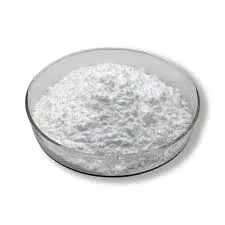
Dec . 05, 2024 15:14 Back to list
hpmc gelation temperature
HPMC Gelation Temperature Understanding the Thermoresponsive Behavior of Hydroxypropyl Methylcellulose
Hydroxypropyl methylcellulose (HPMC) is a widely used cellulose derivative in various industries, including pharmaceuticals, food, and cosmetics. One of its most notable properties is its thermoresponsive behavior, particularly its gelation temperature. This concept is crucial for applications where HPMC serves as a thickening agent, binder, or emulsifier. The gelation temperature influences the gel's formation, stability, and properties, making it a vital parameter in product formulation.
HPMC Gelation Temperature Understanding the Thermoresponsive Behavior of Hydroxypropyl Methylcellulose
The mechanism behind HPMC gelation involves molecular interactions such as hydrophobic associations, hydrogen bonding, and water retention. When heated, the hydrophobic domains of the HPMC chains begin to aggregate, forming a three-dimensional network that entraps water, leading to gel formation. The presence of water plays a crucial role, as it acts as a plasticizer, maintaining the flexibility and fluidity of the gel at higher temperatures. As the temperature rises and the water starts to evaporate, the gel becomes more rigid, which is a critical factor to consider in formulations intended for varying thermal conditions.
hpmc gelation temperature

Understanding the gelation temperature of HPMC is particularly important in pharmaceutical applications. For instance, in drug delivery systems, HPMC is often used to create controlled-release formulations. The gelation temperature can be precisely tailored to ensure that the drug is released at the desired site and rate in the body. By modifying the HPMC's properties, formulators can design systems that are responsive to body temperature, ensuring optimal drug absorption while minimizing side effects.
In the food industry, HPMC's gelation temperature affects how it functions as a thickening agent or stabilizer. Products like sauces, dressings, or gluten-free baked goods benefit from HPMC's ability to form stable gels that provide desired textures without adding significant calories. The ability to adjust the gelation temperature through changes in concentration or the addition of other ingredients allows food scientists to create customized textures and flavors tailored to consumer preferences.
Moreover, in cosmetic formulations, the gelation temperature has implications for stability and performance. Topical products such as creams, lotions, and gels rely on HPMC to deliver active ingredients effectively. A proper understanding of gelation allows cosmetic chemists to formulate products that maintain their consistency and enhance the skin's feel upon application.
In summary, the gelation temperature of HPMC is a critical parameter influencing its behavior and application in various fields. By understanding the factors that affect gelation, researchers and formulators can harness HPMC's properties to create innovative products in pharmaceuticals, food science, and cosmetics. As technology and research continue to advance, the potential for HPMC will likely expand, paving the way for new and exciting applications that capitalize on its unique thermoresponsive characteristics.
-
Versatile Hpmc Uses in Different Industries
NewsJun.19,2025
-
Redispersible Powder's Role in Enhancing Durability of Construction Products
NewsJun.19,2025
-
Hydroxyethyl Cellulose Applications Driving Green Industrial Processes
NewsJun.19,2025
-
Exploring Different Redispersible Polymer Powder
NewsJun.19,2025
-
Choosing the Right Mortar Bonding Agent
NewsJun.19,2025
-
Applications and Significance of China Hpmc in Modern Industries
NewsJun.19,2025







